Magnesium - 3 Easy Ways to Boost it
If you are a family that does their best to avoid plant anti-nutrients, then you may be wondering how you can get enough magnesium into your family’s daily regimens. Many plant sources of magnesium are also high in plant anti-nutrients that actually add potentially harmful anti-nutrients into the body OR they block the absorption of magnesium, as well as the other minerals that are naturally in those plant foods.
Another fact is that the majority of children don’t actually get enough magnesium each day. Most kids eat a plethora of foods that are high in refined grains and other processed foods. These foods strip the body of magnesium.
Stress also strips our bodies of magnesium. When we are more stressed, our body uses up more magnesium. In this challenging modern world, most of us deal with a lot of stressors, including our kids.
So, how do we get magnesium into our bodies? I always say: “FOOD FIRST” when it comes to getting the nutrients that our bodies need. However, since the amount of magnesium in foods and drinking water is much less nowadays, it’s hard to always rely on that to meet all of our magnesium needs. I’ve written extensively about relying on whole foods for the bulk of our nutrition rather than lab-created supplements.
It’s a great idea to make sure we do focus on eating low plant anti-nutrient plant and animal foods, however, it’s helpful to add magnesium into our bodies in other ways as well. That’s the purpose of this article – to help give you suggestions for adding more magnesium to your family’s daily regimen. It’s really rather simple to follow these tips once you get into the routine of making them. Let’s learn more first about magnesium!
Magnesium for Kids
Magnesium is a life-giving mineral for our kids and has a big impact on their overall health. In fact, magnesium plays an essential role in the body’s overall functioning and well-being, from energy production to nerve function. It also helps improve sleep quality and reduce stress levels.
Symptoms of magnesium deficiency in kids range from fatigue to indigestion, poor sleep, tingling to nausea, and heart arrhythmias. However, your kids may not actually be able to convey these symptoms to you, plus it’s hard to connect the dots they are actually causing a magnesium deficiency.
If your kids aren’t able to express that they are super tired or that their legs feel tingly, then how can you know if your kids are experiencing a magnesium deficiency? A few signs of magnesium deficiency in kids are lack of focus, teeth grinding, bedwetting, twitching, poor sleep, digestive issues, and sensitivity to noise. If your child experiences any of those issues then you may want to see if incorporating more magnesium into their day helps.
Benefits of Magnesium
Magnesium is a crucial mineral for the human body, involved in countless enzymatic processes, and the fourth most abundant mineral in our organs. Without it, our cells could not survive!
The benefits of magnesium are vast and include better energy levels, but there are many more. The list below is not exhaustive. Magnesium actually has a lot more benefits than we are going to cover in this article.
Pin for Later
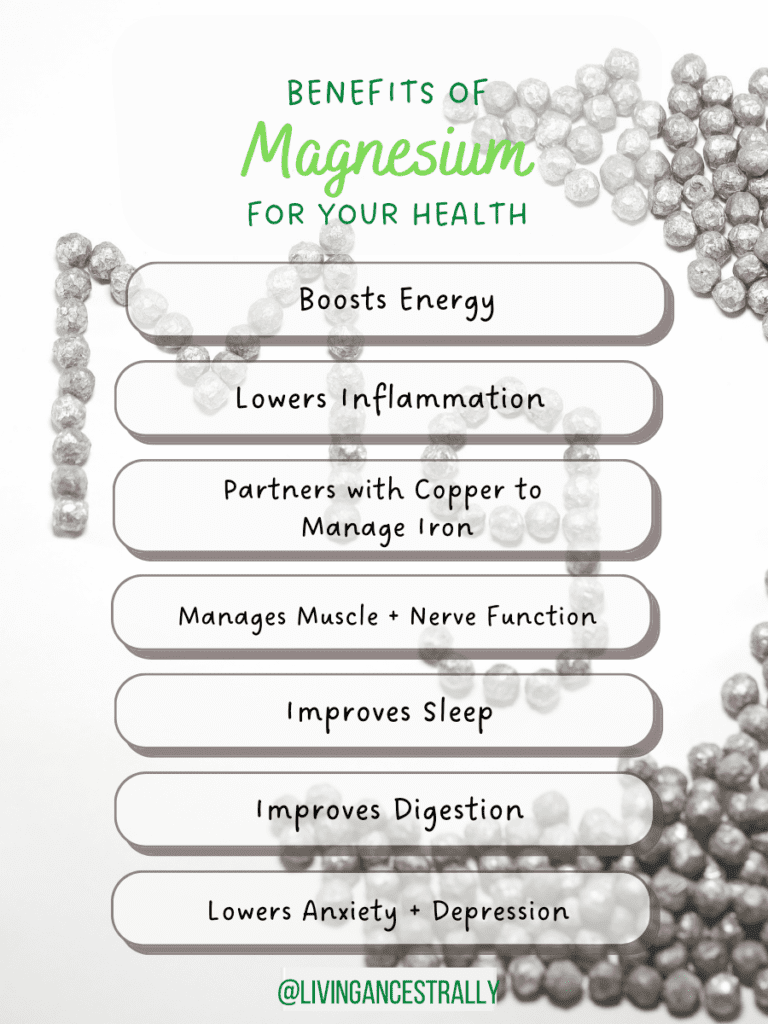
Food Sources of Magnesium
When it comes to getting enough magnesium, there are two main sources: plant and animal foods. Plant foods that are high in magnesium include spinach, Swiss chard, pumpkin seeds, almonds, black beans, avocado, quinoa, and dark chocolate. However, the majority of those foods have plant anti-nutrients in them so they aren’t ideal to consume on a regular basis.
Perhaps they are fine for most people on occasion, but nutritionally, are they the best to rely on on a regular basis? Let’s dive into which foods are actually best and optimal for digestion.
Plant Sources of Magnesium
There are a few decent plant sources of magnesium. One of our personal favorites is sprouted pumpkin seeds since there is about 168 mg of magnesium per 1 ounce of pumpkin seeds. That’s a lot!
Why do I recommend sprouted pumpkin seeds to my clients (and everyone else)?! Raw pumpkin seeds do contain anti-nutrients which is why I don’t recommend eating them raw. However, if you soak them and then sprout them, many of their anti-nutrients are reduced.
Pumpkin seeds have great nutritional (and even medicinal) value but they must be properly prepared as most seeds do. Soaking pumpkin seeds will remove the phytic acid. Sprouting pumpkin seeds activates the seeds’ own digestive enzymes, which helps your body break down the nutrients in the seeds more effectively.
Pumpkin seeds also contain oxalates (another plant anti-nutrient). Research shows that soaking, sprouting, and then boiling high-oxalate plant foods will help to reduce oxalates, however, the digestive enzymes as well as the minerals might be reduced as a result of the high heat.
Another plant source of magnesium is avocados. Avocados are HIGH in magnesium and LOW in plant defense chemicals which makes them an ideal source of magnesium.
One drawback to avocados is that they only grow in certain parts of the world, so they are not a local food to most people even though you can find them at most grocery stores any time of the year.
If you can grow an avocado tree all year long in a greenhouse or in your own home then that is ideal! However, many people are unable to do that. So, buying avocados at the store is the route most people must go if they want avocados. There is about 60 mg of magnesium in one medium avocado.
My third favorite plant source of magnesium is coconut water. Again, it’s not a local food for most people, however, it’s relatively high in magnesium. In fact, there is around 60 mg of magnesium in 1 cup of coconut water. That’s a good amount! You can even make your own coconut water from a whole coconut. It’s easy to do and is more affordable than buying ready-made coconut water.
Pin for Later
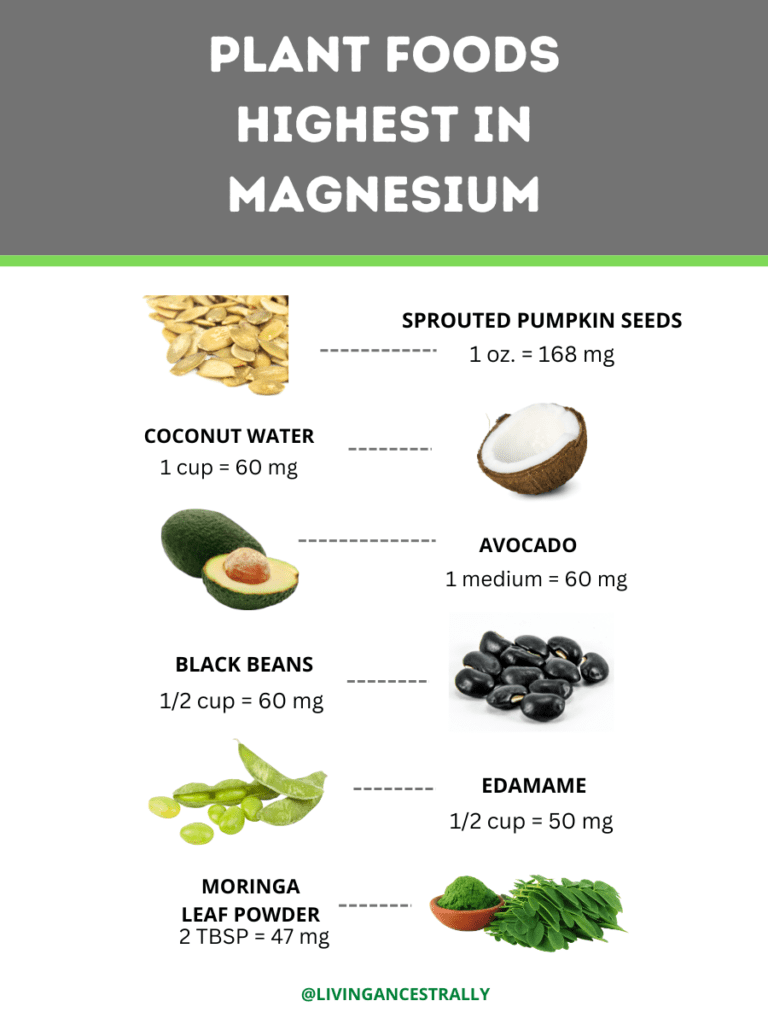
Animal Sources of Magnesium
Animal sources that are high in magnesium include sardines, salmon, mackerel, and halibut. If you notice, all of those are types of seafood! Creatures and even plant foods that come from the ocean are extremely high in minerals due to the saltwater. According to my research, mackerel contains the most magnesium among animal-based food sources (see the graphic below).
A few benefits of relying on animal-based foods for the bulk of your nutrients is that they do not have plant defense chemicals that can cause inflammation in your body. The nutrients in animal foods are also much more bioavailable and, hence, are better absorbed. Basically, you get a bigger bang for your buck when you choose animal-based foods over plant-based foods.
Plant foods have their place though. Ancestral cultures relied on plant foods as backup sources of food when they could not get enough animal-based foods. Perhaps, we should look at plant foods the same way that they did.
Pin for Later
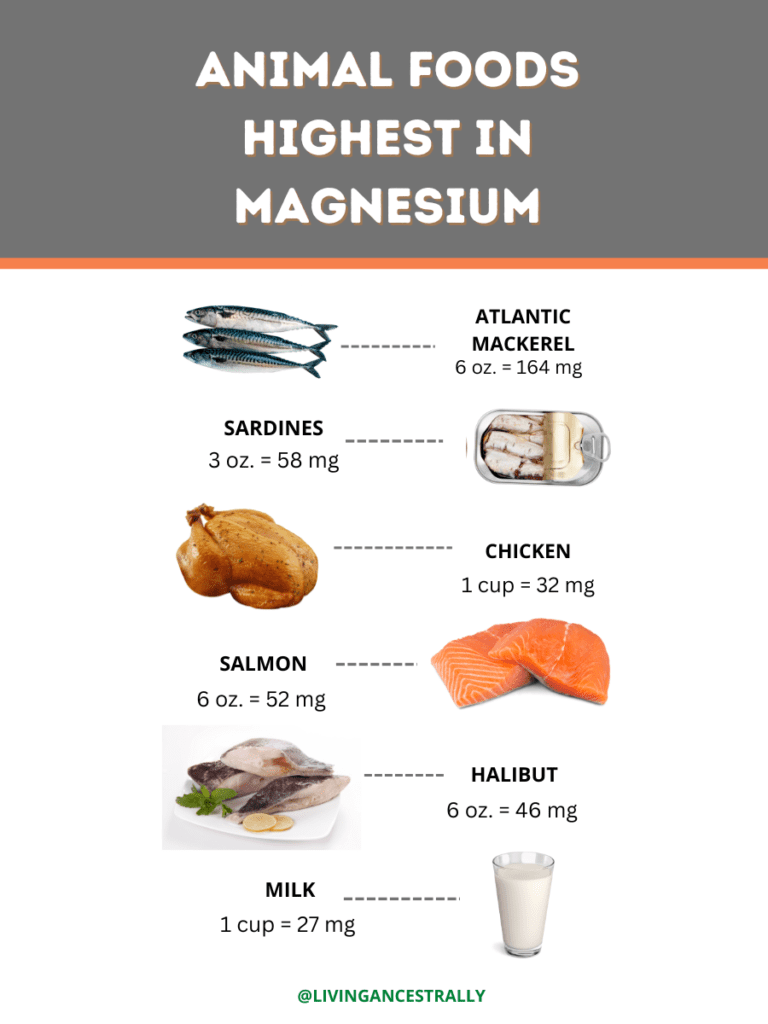
3 Top Natural Magnesium Sources for Kids
Other than magnesium-rich whole food options, I like to recommend magnesium lotion, magnesium water, and/or magnesium gummies as ways to add magnesium to my nutrition client’s day.
All of the recipes for each of those magnesium-rich options are included in this article. Let’s discuss the benefits of each of these magnesium sources.

Nutrition Check-up for Kids
Even kids can get a non-invasive hair mineral test (HTMA) to check the balance of minerals in their bodies.
Mineral imbalances (and high heavy metal levels) lead to tantrums, poor sleep, gut issues, anxiety, hyperactivity, and more. Consider getting an HTMA for your children to optimize their nutrition!
Magnesium Lotion
This is perhaps one of the easiest ways to get a good amount of magnesium into your children’s bodies. It’s easy to slather some on their feet before bedtime. You can add relaxing essential oils into your magnesium lotion that will also help to calm and relax your child before bed.
The form of magnesium in magnesium lotion is magnesium chloride. This is a transdermal form of magnesium that is absorbed through the skin. It obviously bypasses the digestive system so it is absorbed quite quickly into the bloodstream.
Magnesium Lotion Recipe
Our family has also used magnesium lotion to help alleviate headaches, stomachaches, and muscle aches. Simply apply the magnesium lotion directly to the area that is hurting.
You can certainly make your own magnesium lotion! Or you can buy some if that works better for you. We like the brand Earthley. It’s more cost-effective if you buy directly from their website than from a third-party seller.
However, we like making a big batch of our own magnesium lotion because it’s more affordable, we like being self-sustainable, and we can also change the essential oils we add based on the season!
Making magnesium lotion is a fun project that you can do as a family! Plus, you are providing an excellent hands-on activity that teaches your children a pretty basic yet important health lesson on the value of magnesium.
Pin for Later

How Much Magnesium Is In This Magnesium Lotion?
According to our calculations, there are about 280 mg of elemental magnesium in 1 teaspoon of this recipe. That’s quite a lot!
Will Magnesium Lotion Or Magnesium Oil Make Me Itchy?
One note of caution that we’ve experienced is that when we’ve gone a while without applying magnesium lotion, we sometimes experience a slight burning sensation. The reason why this happens is that when someone is deficient in magnesium, it may burn when you apply it to the skin.
If this happens to anyone in your family, see if they can leave the lotion on for about 15-20 minutes before wiping it off with a wet cloth. It should be absorbed into the bloodstream after that amount of time. Eventually, they should not experience that burning sensation if it’s consistently applied to the skin.
Magnesium Water
Ancestral cultures used to get plenty of magnesium in their water (as well as their food). The form of magnesium that they got in the drinking water that they collected from running streams was magnesium bicarbonate.
Since we don’t collect water in the same way, we have to make our own form of magnesium bicarbonate water, aka “mag water”. It’s a highly absorbable form of magnesium that actually neutralizes acidic waste inside the body and increases magnesium levels in humans. In fact, it’s been shown in research to increase serum magnesium levels.
Think of the bicarbonate part of the mag water as a body buffer – it works to maintain a healthy pH in our body by buffering acid in our cells.
Three key systems hold our body’s acid-base balance in check: the respiratory system (lungs), urinary system (kidneys), and the bicarbonate buffering system.
These three systems need bicarbonate present in order to work properly. The majority of people aren’t getting bicarbonate on a daily basis. Our lungs remove excess carbon dioxide, our urinary system removes excess acids from our urine, and our bicarbonate buffering system buffers acids in our cells. But when our organs aren’t functioning optimally or when our diets are poor and we aren’t getting enough bicarbonates, then our bodies can struggle to maintain a healthy pH balance. This can lead to a variety of health issues.
Sometimes, medications, inflammation, and poor diet get in the way of our organs functioning properly. When that happens, our body can’t remove or buffer acid effectively. So, supplying our family with this life-giving mineral water helps their bodies to buffer the acid that may build up as they age.
Magnesium Water Recipe
Depending on the size of your family, this magnesium water can be made weekly or bi-weekly. It takes about 2 minutes of active time and 1.5 hours of inactive time, so it’s not very labor-intensive to make.
It’s a very concentrated solution, so a little goes a long way. A serving is one ounce, so there are 128 servings in a gallon-sized jug. For kids, generally, 1-2 ounces a day is more than enough. It depends on their age and gender though.
Pin for Later
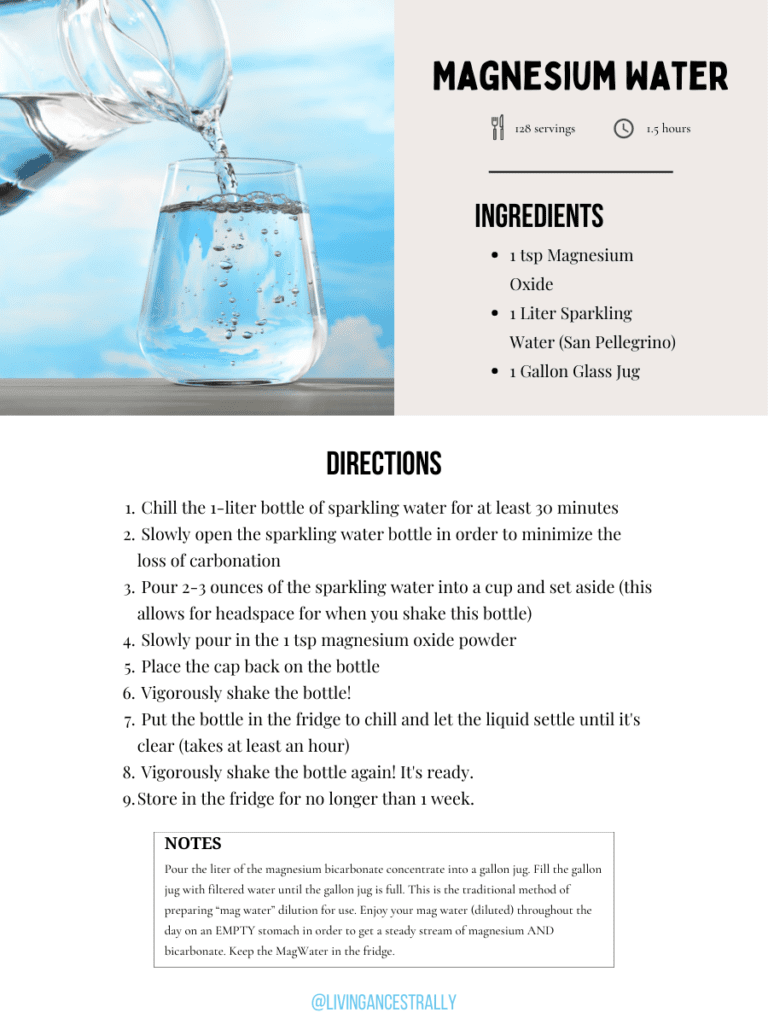
Tips for Giving Kids Magnesium Water
Mag water has a very distinct taste and some people don’t like it. You may find it easier for your children to drink it if you add some to lemonade or naturally flavored water.
One idea is to simply add 1-3 ounces of magnesium water to some homemade lemonade.
Our family likes to make a big batch of lemonade every week, we squeeze several lemons and add water, organic stevia, or monk fruit to a big half-gallon jug. Then I add 1-3 ounces of magnesium water to each of our glasses. It’s super EASY and delicious!
To add some extra magnesium, as well as some potassium to your mineral water, you could also add some unsweetened coconut water to your lemonade.
How Much Magnesium Is In This Magnesium Water Recipe?
Each ounce of this magnesium water contains about 50 mg of elemental magnesium. It is highly concentrated, so a little goes a long way. Try a little bit at a time to see how your body reacts. Slowly increase the amount until your family is consuming the magnesium amount that each person needs.
It’s also advisable to drink magnesium bicarbonate water on an empty stomach since it helps to lower the acid in your body. We don’t want our stomachs to be LESS acidic when we eat food. We need our stomachs to be acidic in order to break down our food and destroy pathogens. Drinking magnesium water too close to eating time could affect that process. However, if you are eating a lighter meal that is easier to digest then drinking mag water close to that meal might not affect your digestion too much.
Why Do You Recommend San Pellegrino Water?
There are many different sparkling water brands. Each one has a different calcium-to-magnesium ratio. San Pellegrino has a 3:1 calcium-to-magnesium ratio which aligns closely with the ideal 2:1 ratio that is recommended by experts.
Plus, San Pellegrino is relatively easy to find in most stores. Beware of other brands with unusually high calcium-to-magnesium ratios, such as Perrier, which is reported to contain as much as 147 parts calcium to just 3 parts magnesium – a level well outside of the ideal range. Some people would say that that’s a “heart attack in a bottle”.
Magnesium-Rich Gummies
Magnesium gummies are one of the tastiest ways to get magnesium into the body! You certainly don’t have to, but we use raw milk from a local dairy in our magnesium-rich gummies. By doing so, we are providing our bodies with a hefty dose of minerals such as magnesium, potassium, and calcium (to name just a few), as well as a good amount of probiotics and enzymes that help to improve our digestion.
If you have concerns about your family consuming raw milk then I urge you to read this article as well as other non-biased sources on the topic. The widely held belief of most conventional healthcare professionals that raw milk is dangerous is unfounded and recent peer-reviewed internationally published research.
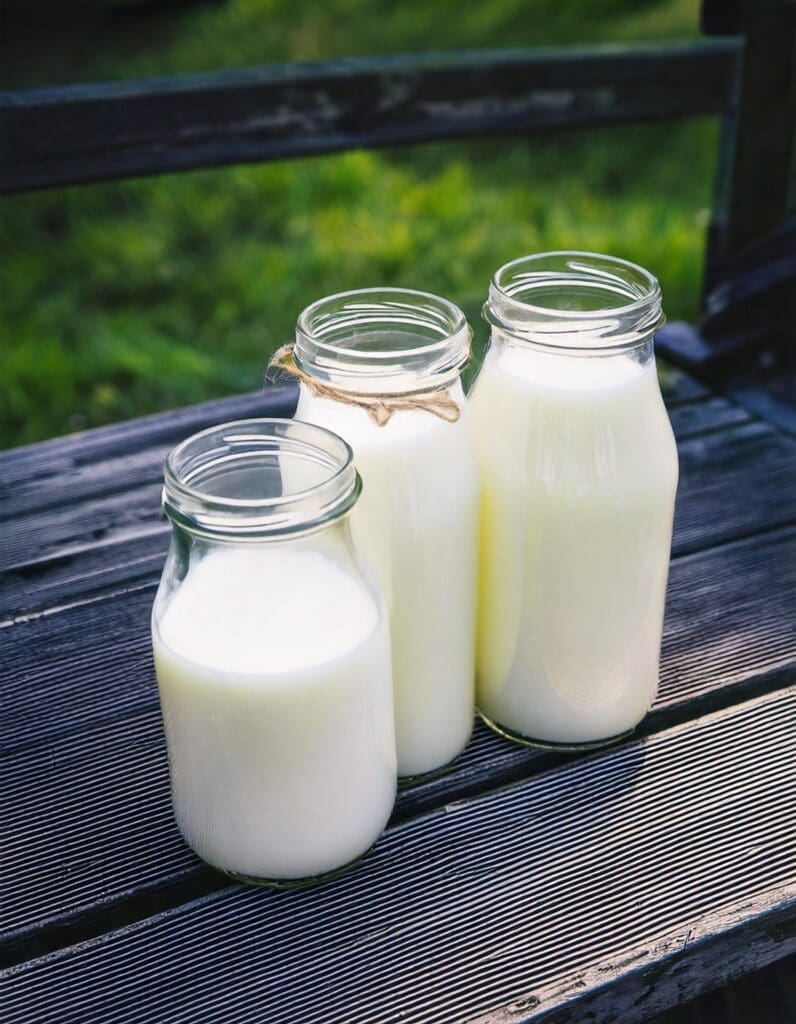
The research shows that raw milk that comes from Concentrated Animal Feeding Operations in which the animals live in terrible conditions and are given antibiotics and hormones is indeed an unsanitary source of raw milk.
However, raw milk sourced from a sanitary dairy that carefully produces its milk for human consumption should be safe. However, we encourage you to do your own research and always use your best judgment since it’s a decision that you have to make for your family.
Read this well-written resource to learn more.
The website called Real Milk has a Raw Milk Finder so you can see if there are farmers near you that sell raw milk. You could also ask around at your local farmer’s market. Or do an internet search for nearby farmers in your area that sell milk to ask them if they know anyone that sells raw milk. It is illegal in some places to sell raw milk. You may be able to find information on www.realmilk.com about your local laws.
Benefits of Raw Milk
✔️ Contains all 22 Essential Minerals
✔️ Contains Digestive Enzymes: Lactase (breaks down the lactose sugar), Protease (breaks down protein), Lipase (breaks down fat), Lactoperoxidase (an antibacterial enzyme)
✔️ Contains Gut-Friendly Probiotics (heating milk destroys microbes)
✔️ Contains More Bioavailable Calcium and Phosphorus than Pasteurized Milk
✔️ Contains More Copper and Iron than Pasteurized Milk
The heat produced during the pasteurization process inactivates all of the enzymes mentioned above, as well as many others. It also kills the healthy probiotics and reduces the bioavailability of nutrients such as vitamins A, D, & K, copper, iron, calcium, and phosphorus – to name a few.
You can always use a different type of milk if you want to steer clear of raw milk.
Now that that’s out of the way, let’s move on to the magnesium gummy recipe!
Magnesium Gummies Recipe
These magnesium-enriched gummies get their magnesium content from three different sources: coconut water, magnesium citrate, and raw milk.
Due to the high magnesium content as well as the glycine in the gelatin, this makes for an excellent pre-bedtime treat for you or your kids! Magnesium and glycine are both well-known for helping to promote sleep.
If you want to have plenty of these gummies available throughout the week then you might want to double this recipe. However, feel free to just make one batch first to see how your family likes it.
The magnesium citrate is completely optional. It does change the flavor a bit and makes the gummies have a little powdery texture. Adding the magnesium citrate simply increases the magnesium content, however, there is plenty of magnesium within these gummies from the milk and coconut water.
It’s fun to change out the spices and flavors! Try to get your kids involved by asking them what natural add-ins they would like and then let them help make it. Have fun!
Pin for Later

How Much Magnesium is in These Gummies?
It depends on the size of the gummies. If you used an 8×8 baking dish and cut them into 9 equal servings, each piece has about 213 mg of magnesium (1,918 mg in the entire recipe) which is more than enough magnesium per serving for a child. If you are giving this to younger children then I’d recommend using smaller silicone molds for this recipe. By doing so, there will be less magnesium per serving if you use small molds.
Do your research and use your best judgment on how much to give your child. It’s advisable that you start slowly when first giving these to your family.
Getting Enough Magnesium
Magnesium may be a basic mineral, but it’s essential for the health and well-being of your entire family. The benefits of magnesium are extensive and can have a significant positive impact on your children’s development. It plays a vital role in bodily functions such as muscle contraction, energy production, regulating blood pressure levels, and maintaining healthy teeth and bones – and don’t forget, it helps with calcium absorption too.
Getting enough magnesium should hopefully be a little easier with the three recipes shared in this article. None of the recipes take a lot of time to make. It may be helpful to start with just one of the recipes for a week to see how your family reacts to that before adding in any of the other magnesium recipes.
Ensuring that your children are getting enough magnesium shouldn’t be difficult if you are strategic about it. Hopefully, the recipes in this article will be helpful. If you make any of the recipes then please tag me on Instagram (@livingancestrally) so I can see how it went!
Please note that A Hair Mineral Analysis (HTMA) is not intended to diagnose, treat, cure, reverse, or prevent any disease. It is not intended to replace any other medical test(s) that may be prescribed by your medical doctor.
